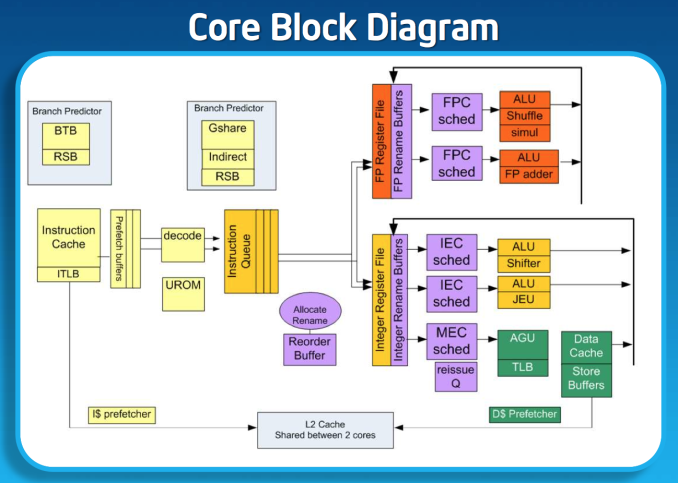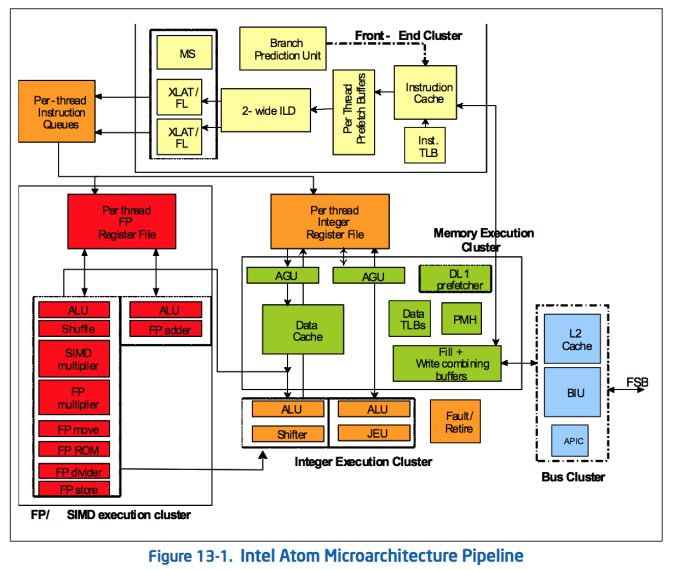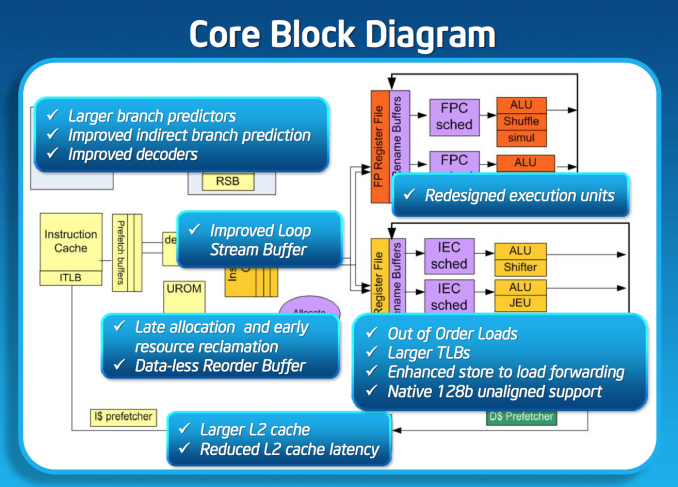Intel’s Silvermont Architecture Revealed: Getting Serious About Mobile
by Anand Lal Shimpi on May 6, 2013 1:00 PM EST- Posted in
- CPUs
- Intel
- Silvermont
- SoCs
Sensible Scaling: OoO Atom Remains Dual-Issue
The architectural progression from Apple, ARM and Qualcomm have all been towards wider, out-of-order cores, to varying degrees. With Swift and Krait, Apple and Qualcomm both went wider. From Cortex A8 to A9 ARM went OoO and then from A9 to A15 ARM introduced a significantly wider architecture. Intel bucks the trend a bit by keeping the overall machine width unchanged with Silvermont. This is still a 2-wide architecture.
At the risk of oversimplifying the decision here, Intel had to weigh die area, power consumption as well as the risk of making Atom too good when it made the decision to keep Silvermont’s design width the same as Bonnell. A wider front end would require a wider execution engine, and Intel believed it didn’t need to go that far (yet) in order to deliver really good performance.
Keeping in mind that Intel’s Bonnell core is already faster than ARM’s Cortex A9 and Qualcomm’s Krait 200, if Intel could get significant gains out of Silvermont without going wider - why not? And that’s exactly what’s happened here.
If I had to describe Intel’s design philosophy with Silvermont it would be sensible scaling. We’ve seen this from Apple with Swift, and from Qualcomm with the Krait 200 to Krait 300 transition. Remember the design rule put in place back with the original Atom: for every 2% increase in performance, the Atom architects could at most increase power by 1%. In other words, performance can go up, but performance per watt cannot go down. Silvermont maintains that design philosophy, and I think I have some idea of how.
Previous versions of Atom used Hyper Threading to get good utilization of execution resources. Hyper Threading had a power penalty associated with it, but the performance uplift was enough to justify it. At 22nm, Intel had enough die area (thanks to transistor scaling) to just add in more cores rather than rely on HT for better threaded performance so Hyper Threading was out. The power savings Intel got from getting rid of Hyper Threading were then allocated to making Silvermont an out-of-order design, which in turn helped drive up efficient use of the execution resources without HT. It turns out that at 22nm the die area Intel would’ve spent on enabling HT was roughly the same as Silvermont’s re-order buffer and OoO logic, so there wasn’t even an area penalty for the move.
The Original Atom microarchitecture
Remaining a 2-wide architecture is a bit misleading as the combination of the x86 ISA and treating many x86 ops as single operations down the pipe made Atom physically wider than its block diagram would otherwise lead you to believe. Remember that with the first version of Atom, Intel enabled the treatment of load-op-store and load-op-execute instructions as single operations post decode. Instead of these instruction combinations decoding into multiple micro-ops, they are handled like single operations throughout the entire pipeline. This continues to be true in Silvermont, so the advantage remains (it also helps explain why Intel’s 2-wide architecture can deliver comparable IPC to ARM’s 3-wide Cortex A15).
While Silvermont still only has two x86 decoders at the front end of the pipeline, the decoders are more capable. While many x86 instructions will decode directly into a single micro-op, some more complex instructions require microcode assist and can’t go through the simple decode paths. With Silvermont, Intel beefed up the simple decoders to be able to handle more (not all) microcoded instructions.
Silvermont includes a loop stream buffer that can be used to clock gate fetch and decode logic in the event that the processor detects it’s executing the same instructions in a loop.
Execution
Silvermont’s execution core looks similar to Bonnell before it, but obviously now the design supports out-of-order execution. Silvermont’s execution units have been redesigned to be lower latency. Some FP operations are now quicker, as well as integer multiplies.
Loads can execute out of order. Don’t be fooled by the block diagram, Silvermont can issue one load and one store in parallel.













174 Comments
View All Comments
Ortanon - Monday, May 6, 2013 - link
This.jamesb2147 - Monday, May 6, 2013 - link
That's not an excuse for subjective fluff. Don't get me wrong, I particularly liked the Bulldozer performance reviews and analysis. The reason I liked them was the hard data used to develop ideas about possible use-case scenarios for the CPU's. This article is full of "IT'S GONNA BE AWESUMMMMMM!!!!!1!!!" and not so much nuanced, objective reporting on actual news. It has plenty of analysis, but without concrete evidence, it reads like one of those all-too-familiar forum rants from HardForum or the like, full of people with too much time and not enough to do.If Anandtech is evolving into one of those news outlets that has to keep writing articles to keep people engaged, then I'm not interested. And it's not just my loss, it's the readership's.
wsw1982 - Tuesday, May 7, 2013 - link
if the clover trail+ already has similar performance as the best ARM offer, and the silvermont is said to be 2 times better than clover trail+. What should be the most logic sentiment in your opinion?phoenix_rizzen - Tuesday, May 7, 2013 - link
Well, you're comparing some future Intel SoC that no one has been allowed to actually touch/test (using only Intel's internal "benchmarking") against currently available ARM SoCs. Who knows what the performance will be like for ARM SoCs in 8-12 months, when these Intel SoCs are actually, physically able to be benchmarked.Cautious optimism is warranted. Not flat-out "OMG, THIS IS THE BESTEST EVAR!" fluff like this article spouts.
Spunjji - Wednesday, May 8, 2013 - link
Restrained optimism and a desire for further evidence. I can only assume Anand has already seen more than us, as his attitude is somewhat more positive than that. If he hasn't, well, I have expressed the opinion before that I find he treats Intel press releases rather lightly.cjb110 - Tuesday, May 7, 2013 - link
tbh that's an OTT response, AnandTech have done a piece based on the info they have and their previous experience. Everything mentioned is reasoned out in a logical progression. You might not always agree with the reasoning but its most certainly isn't 'fluff'. There will be a data based analysis later, as always.Krysto - Monday, May 6, 2013 - link
But not entirely unbiased. Making a detailed analysis and being biased aren't mutually exclusive.Krysto - Monday, May 6, 2013 - link
See asymco.com (apple fanboi doing "indepth analysis" about Android and other competitors.. Guess what? They usually favor Apple).Homeles - Monday, May 6, 2013 - link
I doubt there's a single human being on the face of the planet that is unbiased. What's your point?Thrill92 - Tuesday, May 7, 2013 - link
Oh no, your going to have to do some critical thinking about the data and conclusions in media. What ever will you do?